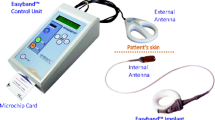Abstract
Background
Nowadays, obesity is frequently an indication for implantation of an adjustable stomach or gastric band. Among the side effects, in addition to band erosion and port chamber complications, pouch dilation in the sense of increasing enlargement of the forestomach and resulting insufficiency of initial surgical measures consistently occurs. Implantation of a soft basket band will prevent this. The objective of this study was to investigate the practical feasibility of the soft basket band.
Methods
Ten patients were investigated in an observation study over a period from November 2006 to June 2007. Seven patients were women and three patients were men, with an average age of 43.6 years (25–66 years).
Results
The average body mass index (BMI) at the time of the operation was 47.4 ± 5.5 kg/m2, with an average body weight of 134.5 ± 24.6 kg. After a median follow-up period of 1 month, an average BMI of 44.9 ± 5.8 kg/m2 was achieved, and after 3 months, an average BMI of 41.4 ± 4.8 kg/m2. The excessive weight loss was 7.4 ± 4.3 kg after 1 month and 17.9 ± 6.4 kg after 3 months. A local wound infection occurred as a complication in one patient.
Conclusion
Laparoscopy procedures enable mortality to be lowered compared to bypass operations with minimal complications and substantial reduction of weight.





Similar content being viewed by others
References
Miller K. Laparoskopische Operationsverfahren bei morbider Adipositas. J Ernährmed. 2005;5:5–11.
Ren CJ, Fielding GA. Laparoscopic adjustable gastric banding: surgical technique. J Laparoendosc Adv Surg Tech. 2003;13:257–63.
Busetto L, Segato G, de Marchi F, et al. Postoperative management of laparoscopic gastric banding. Obes Surg. 2003;13:121–7.
National Center for Health Statistics. Prevalence of overweight and obesity among adults. United States 2003–2004. http://www.cdc.gov/nchs/products/pubs/pubd/hestats/overweight/overwght_adult_03.htm.
Steinbrook R. Surgery for severe obesity. N Engl J Med. 2004;350:1075–9.
Buchwald H, Buchwald JN. Evolution of operative procedures for the management of morbid obesity 1950-2000. Obes Surg. 2002;12:705–17.
Beckett EAH, McGeough CA, Sanders KM, et al. Pacing of interstitial cells of Cajal in the murine gastric antrum: neurally mediated and direct stimulation. J Physiol. 2003;553:545–59.
Chen JZ, Ueno T, Xu X, et al. Reverse gastric pacing reduces food intake without symptoms in dogs. Scand J Gastroenterol 2006;41:30–6.
Deitel M. Applications of electrical pacing in the body. Obes Surg. 2004;14:3–8.
De Luca M, Segato G, Busetto L, et al. Progress in implantable gastric stimulation: summary of results of the European Multi-Center Study. Obes Surg. 2004;14:33–9.
Favretti F, De Luca M, Segato G, et al. Treatment of morbid obesity with the transcend implantable gastric stimulator (IGS): a prospective survey. Obes Surg. 2004;14:666–70.
Miller KA. Implantable electrical gastric stimulation to treat morbid obesity in the human: operative technique. Obes Surg. 2002;12:17–20.
Neshev E, Onen D, Jalilian E, et al. Pre-pyloric neural electrical stimulation produces cholinergically-mediated reverse peristalsis in the acute canine model of microprocessor-invoked gastric motility for the treatment of obesity. Obes Surg. 2006;16:510–20.
Yao S-K, Ke M, Wang Z, et al. Retrograde gastric pacing reduces food intake and delays gastric emptying in humans: a potential therapy of obesity? Dig Dis Sci. 2005;50:1569–75.
Yao S-K, Ke M-Y, Wang Z-F, et al. Visceral response to acute retrograde gastric electrical stimulation in healthy human. World J Gastroenterol. 2005;11:4542–46.
Ceelen W, Walder J, Cardon A, et al. Surgical treatment of severe obesity with low-pressure adjustable gastric band: experimental data and clinical results in 625 patients. Ann Surg. 2003;237:10–6.
Angrisani L, Alkilani M, Basso N, et al. Laparoscopic Italian experience with the Lap-Band. Obes Surg. 2001;11:307–10.
Zappa MA, Micheletto G, Lattuada E, et al. Prevention of pouch dilatation after laparoscopic adjustable gastric banding. Obes Surg. 2006;16:132–6.
Morone G. Could a mesh above the band be the solution to the enlargement of proximal gastric pouch? A preliminary series of patients treated with Basket Band. Abstracts of Oral Presentations, 11th World Congress of IFSO, Sydney, Australia. Obes Surg. 2006;16:972–92.
Weiss H, Nehoda H, Labeck B, et al. Injection port complications after gastric banding: incidence, management and prevention. Obes Surg. 2000;10:259–62.
Author information
Authors and Affiliations
Corresponding author
Rights and permissions
About this article
Cite this article
Krukemeyer, M.G., Dietl, KH., Loermann, P. et al. A New Laparoscopic Technique for Weight Reduction with Implanted Gastric Banding Basket. OBES SURG 18, 353–358 (2008). https://doi.org/10.1007/s11695-007-9366-x
Received:
Accepted:
Published:
Issue Date:
DOI: https://doi.org/10.1007/s11695-007-9366-x




